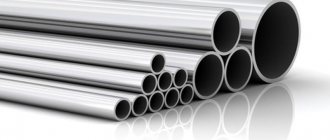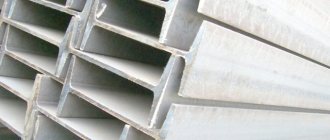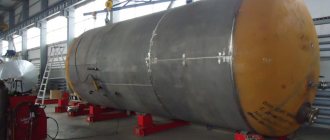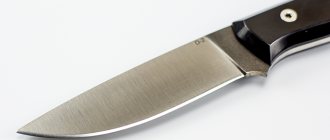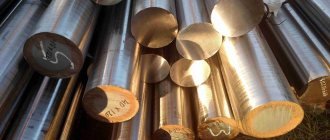Technological properties
The ease of weldability of the material allows the use of any welding method. The main indicators of the alloy, which are used to divide it into separate groups according to strength, include:
- anti-corrosion properties;
- mechanical parameters;
- weldability.
If an element made from this steel grade has a thickness of more than 36 mm, then heat treatment is performed after welding. This is due to the need to relieve residual stresses in the weld zone, which are formed during local heating during welding.
Return to content
Welding material
This material lends itself quite well to influences such as welding. A wide range of technical parameters, which can also be modified using various additives, are considered universal. Excellent weldability is one of the first advantages that steel has.
The properties and parameters of the raw material allow the use of automatic and manual arc welding. In addition, the use of contact-point and electroslag methods is allowed. It is also worth noting that this material can be successfully used for the production of forged items.
Application of steel
The characteristics of ST3KP steel ensure the effectiveness of using the material in the manufacture of load-bearing and secondary structures, machine parts and equipment. It can only be used at positive ambient temperatures. More universal products are obtained from rolled products of category 5. They can be used at temperatures of -40/+425 degrees, as well as under variable load.
Larsen tongue and groove from ST3KP
The creation of complex structures involves heat treatment as the final stage of production. The most popular is annealing, which reduces stress in elements after welding.
The scope of application of ST3KP covers the production of At-400S fittings. Sheets made from the alloy are subjected to cold stamping without reducing technical characteristics. The most widely used are troughs for collecting cutting fluids and oils, tanks, machine covers, casings, etc.
Return to content
content .. 57 58 59 60 ..0.01.1.01.OE(m)-I. Tickets with answers for certification according to NAKS
General exam General exam. (m) Level: I (with answers)
1
| Question_OE/1 Which ordinary quality steel is classified as boiling steel? | |
| 1. | Steel not completely deoxidized by manganese during smelting, and containing no more than 0.05% silicon. |
| 2. | Containing silicon from 0.05 to 0.17%. |
| 3. | Containing more than 10 ml. hydrogen per 100 g of metal. |
| 2 | Question_OE/1 What type of steel of ordinary quality is considered mild steel? |
| 1. | Steel, completely deoxidized during smelting and containing 0.15-0.3% silicon |
| 2. | Containing at least 0.3% silicon and 1% manganese. |
| 3. | Containing less than 0.5 ml. hydrogen per 100 g of metal. |
| 3 | Question_OE/1 Which ordinary quality steel is classified as semi-quiet? |
| 1. | Steel deoxidized during smelting only with manganese and containing no more than 0.05% silicon. |
| 2. | Steel that is not completely deoxidized during smelting with only manganese and silicon and contains 0.05 - 0.15% silicon and up to 1% manganese |
| 3. | Containing less than 10 ml. hydrogen per 100 g of metal |
| 4 | Question_OE/1 What class of steels do welding wires Sv-08, Sv08A, Sv-08GA, Sv-10GA belong to? |
| 1. | Low carbon. |
| 2. | Alloyed. |
| 3. | Highly alloyed. |
| 5 | Question_OE/1 What are alloy steels? |
| 1. | Containing one or more elements in certain concentrations, which are introduced into them in order to impart specified physicochemical and mechanical properties. |
| 2. | Possessing certain physical and chemical properties due to reduction in the content of carbon, sulfur, phosphorus or heat treatment. |
| 3. | Possessing certain physical and chemical properties after special thermomechanical treatment. |
| 6 | Question_OE/1 What weldability do low-carbon steels have? |
| 1. | Good. |
| 2. | Satisfactory. |
| 3. | Bad. |
| 7 | Question_OE/1 What do the letters and numbers mean in the marking of low-alloy steels? |
| 1. | Manufacturer's marks. |
| 2. | Designation of heat number and batch of metal. |
| 3. | Designation of chemical elements and their percentage composition. |
| 8 | Question_OE/1 Which of the following steels are carbon steels? |
| 1. | St3sp, steel10, steel 15, steel 18kp |
| 2. | 09G2S, 17G1S, 09G2FB. |
| 3. | 08Х18Н9, 10Х2М, 15ХМ. |
| 9 | Question_OE/1 What letter of the Russian alphabet denotes carbon and nickel in the marking of alloy steels? |
| 1. | Carbon - "U"; nickel - "N". |
| 2. | Carbon - “C”; nickel - "L". |
| 3. | Carbon is not represented by a letter; nickel - "N". |
| 10 | Question_OE/1 What changes in properties occur during hardening of low-carbon steels? |
| 1. | Plasticity increases, strength characteristics do not change |
| 2. | Strength characteristics increase, ductility decreases |
| 3. | Both strength and ductility increase |
| 11 | Question_OE/1 What are the main characteristics accepted for assessing the mechanical properties of metals? |
| 1. | Tensile strength, yield strength, elongation and contraction, hardness, impact strength. |
| 2. | Heat resistance, heat resistance and cold resistance of the metal. |
| 3. | Hardness, bending resistance and number of shock loading cycles before metal failure. |
| 12 | Question_OE/1 Why are alloying elements added to steel? |
| 1. | To impart special properties to steel. |
| 2. | To improve the weldability of steel. |
| 3. | To reduce the content of harmful impurities (sulfur and phosphorus) in steel. |
| 13 | Question_OE/1 Indicate how St3kp differs from St3sp? |
| 1. | Carbon content. |
| 2. | Silicon content. |
| 3. | Content of harmful impurities S and P and gases. |
| 14 | Question_OE/1 Why is pre- and post-heating performed? |
| 1. | To reduce the number of defects in the weld and HAZ. |
| 2. | To level out uneven heating during welding, reduce the cooling rate and reduce the likelihood of cold cracks. |
| 3. | To reduce the hydrogen content in the weld metal. |
| 15 | Question_OE/1 What characteristics can be determined by tensile testing of metal samples? |
| 1. | Yield strength, tensile strength. |
| 2. | Bend angle. |
| 3. | Yield strength, tensile strength, relative elongation and transverse contraction. |
| 16 | Question_OE/1 What characteristic is determined by static bending? |
| 1. | Bend angle. |
| 2. | Bending toughness. |
| 3. | Bending strength. |
| 17 | Question_OE/1 What characteristics of the metal are determined during bending (flat samples) and flattening (pipes) tests? |
| 1. | Strength. |
| 2. | Plastic. |
| 3. | Strength and ductility. |
| 18 | Question_OE/1 What characteristics are determined during impact bending? |
| 1. | Impact bending strength. |
| 2. | Impact strength. |
| 3. | Relative elongation during impact bending. |
| 19 | Question_OE/1 What can be assessed by the type of fracture of a welded joint? |
| 1. | Strength, corrosion resistance, density. |
| 2. | The structure of the metal, its continuity and draw a qualitative conclusion about the plastic properties of the metal. |
| 3. | Presence and quantity of harmful impurities. |
| 20 | Question_OE/1 How does high sulfur and phosphorus content affect the weldability of steel? |
| 1. | Does not affect. |
| 2. | Increases weldability when the steel is preheated. |
| 3. | Promotes the appearance of cracks and impairs the weldability of steel. |
| 21 | Question_OE/1 What is a weld in fusion welding? |
| 1. | Crystallized metal from a molten electrode or welding wire. |
| 2. | A section of a welded joint formed as a result of crystallization of molten metal. |
| 3. | Liquid metal obtained by fusion of weldable and filler materials. |
| 22 | Question_OE/1 What determines the properties of a welded joint? |
| 1. | Properties of the weld metal, fusion line with the base metal and heat-affected zone. |
| 2. | Properties of the weld metal and fusion line with the base metal. |
| 3. | Properties of the fusion line with the base metal and the heat-affected zone. |
| 23 | Question_OE/1 How does uneven heating during welding affect the amount of deformation of the base metal? |
| 1. | Increases the amount of deformation. |
| 2. | Does not affect the amount of deformation. |
| 3. | Reduces the amount of deformation. |
| 24 | Question_OE/1 How does an increase in the volume of deposited metal affect the amount of deformation of the base metal? |
| 1. | Reduces the amount of deformation. |
| 2. | Does not affect the amount of deformation. |
| 3. | Increases the amount of deformation. |
| 25 | Question_OE/1 What welding deformations are called residual? |
| 1. | Deformations appearing after welding. |
| 2. | Deformations remaining after welding and complete cooling of the product. |
| 3. | Deformations formed under the influence of operational loads. |
| 26 | Question_OE/1 How does heating of products during the welding process affect the amount of residual deformation? |
| 1. | Increases product deformation. |
| 2. | Reduce product deformation. |
| 3. | Does not affect |
| 27 | Question_OE/1 What determines the amount of deformation of the metal being welded? |
| 1. | From the tendency of steel to harden. |
| 2. | From uneven heating. |
| 3. | From the brand of welding materials. |
| 28 | Question_OE/1 What structural elements characterize the shape of the edges? |
| 1. | Offset edges, angularity. |
| 2. | Bluntness, edge bevel angle. |
| 3. | Method of preparation, clearance. |
| 29 | Question_OE/1 What are the types of welded joints? |
| 1. | Single-sided and double-sided. |
| 2. | Butt, tee, corner, overlap. |
| 3. | Vertical and horizontal. |
| 30 | Question_OE/1 How is a welded joint indicated on a drawing? |
| 1. | The type of connection, welding method and method, and control methods are indicated. |
| 2. | GOST, type of connection, welding method and method, weld leg, length or pitch, special designations are indicated. |
| 3. | The method and method of welding, length or pitch, welding material, methods and scope of control are indicated. |
| 31 | Question_OE/1 What do the numbers next to the letters on the drawing indicating the weld mean? |
| 1. | The serial number of the seam according to GOST (OST). |
| 2. | Welding method and method. |
| 3. | Methods and scope of control. |
| 32 | Question_OE/1 Which line represents a visible weld in the drawing? |
| 1. | Dash-dotted. |
| 2. | Stroke. |
| 3. | Solid. |
| 33 | Question_OE/1 When should each batch of welding consumables be inspected? |
| 1. | Before the start of its production use. |
| 2. | Simultaneously with its use for production. |
| 3. | On time, regardless of its production use. |
| 34 | Question_OE/1 What parameters need to be monitored after preparing parts and assembly units for welding? |
| 1. | Shape, size and quality of edge preparation; correctness of transitions from one section to another; other characteristics and dimensions, the control of which is provided by the PKD and PDD. |
| 2. | The quality of cleaning of edges prepared for welding and adjacent surfaces of parts and assembly units. |
| 3. | All parameters specified in paragraphs. 1 and 2. |
| 35 | Question_OE/1 What are the two main groups of control methods based on the impact on the material of a welded joint? |
| 1. | Destructive and irradiating. |
| 2. | Mechanical and electronic. |
| 3. | Destructive and non-destructive. |
| 36 | Question_OE/1 What is the purpose of visual inspection of a welded joint? |
| 1. | In order to identify surface defects in the seam |
| 2. | In order to identify surface defects and defects in seam formation. |
| 3. | In order to identify non-compliance of the structural dimensions of the seam with the requirements of regulatory and technical documentation. |
| 37 | Question_OE/1 How are defects in the shape of a seam and its size detected? |
| 1. | By radiographic method. |
| 2. | Metallographic studies of the macrostructure. |
| 3. | Measuring tools and special templates. |
| 38 | Question_OE/1 What weld defects are detected using radiographic testing, ultrasonic and other equivalent methods? |
| 1. | Cracks, lack of fusion, lack of fusion, pores, non-metallic and metallic inclusions. |
| 2. | Structural changes in metal, internal stresses. |
| 3. | The quality of seam formation from the inside and outside. |
| 39 | Question_OE/1 What is inclusion? |
| 1. | Generalized name for pores, slag and tungsten inclusions. |
| 2. | Non-metallic discontinuity. |
| 3. | Accumulation of several pores. |
| 40 | Question_OE/1 At what point should defects in welded joints subject to subsequent heat treatment (tempering) be corrected? |
| 1. | Before vacation. |
| 2. | In agreement with the parent materials science organization. |
| 3. | After vacation. |
| 41 | Question_OE/1 What defects are allowed to be eliminated by a welder (without involving the work supervisor) during the process of welding a pipe joint? |
| 1. | Any defects, including cracks. |
| 2. | Cracks and inter-roller lack of fusion. |
| 3. | Surface pores, slag inclusions, lack of fusion between rollers, undercuts. |
| 42 | Question_OE/1 What is a crack called? |
| 1. | A defect in a welded joint in the form of a metal rupture in the weld and/or adjacent areas. |
| 2. | Violation of metal continuity. |
| 3. | Inadmissible deviation from the requirements of the Control Rules. |
| 43 | Question_OE/1 What is called a burn-through? |
| 1. | A cylindrical depression in a weld. |
| 2. | Through hole in the weld. |
| 3. | A funnel-shaped depression in a weld. |
| 44 | Question_OE/1 What is called beading in weld metal? |
| 1. | Irregularities in the surface of the weld metal or deposited metal. |
| 2. | A defect in the form of metal that has flowed onto the surface of the metal being welded and or a previously made bead and has not fused with it. |
| 3. | Failure of fusion of the weld metal bead with the base metal. |
| 45 | Question_OE/1 What is time? |
| 1. | A weld defect in the form of a closed cavity filled with foreign metal. |
| 2. | A weld defect in the form of a spherical cavity filled with slag. |
| 3. | A weld defect in the form of a closed cavity filled with gas. |
| 46 | Question_OE/1 What shape can pores have? |
| 1. | Linear or flat. |
| 2. | Straight and curved. |
| 3. | Spherical and elongated. |
| 47 | Question_OE/1 What is an undercut? |
| 1. | A recess along the line of fusion of the weld with the base metal. |
| 2. | Sharp, cone-shaped indentations at the interface of the weld surface with the previous weld bead or base material. |
| 3. | Sharp cone-shaped depressions at the interface between the surface of the weld and the base material. |
| 48 | Question_OE/1 What is “lack of penetration”? |
| 1. | A defect in the form of a lack of fusion between the weld metal and the base metal along the groove edge. |
| 2. | A defect in the form of lack of fusion in a welded joint due to incomplete melting of the edges or surfaces of previously made weld beads. |
| 3. | A defect in the form of lack of fusion in a welded joint due to incomplete melting of the edges or surfaces of previously made weld beads. |
| 49 | Question_OE/1 How should a removed defective section of a seam be welded if the welding was carried out with preheating? |
| 1. | With slow cooling after welding. |
| 2. | At increased welding modes. |
| 3. | Heated. |
| 50 | Question_OE/1 What are the requirements for the quality of the repaired seam section? |
| 1. | The same as for the main seam. |
| 2. | Additional requirements provided for in regulatory and technical documentation. |
| 3. | Special requirements provided for by regulatory and technical documentation. |
| 51 | Question_OE/1 Are cracks identified during visual inspection allowed in welded joints? |
| 1. | Transverse cracks in welds are allowed. |
| 2. | Cracks of all types and directions are not allowed. |
| 3. | Microcracks with an area of no more than 1 sq. mm are allowed. |
| 52 | Question_OE/2 What is “manual arc welding with a covered electrode”? |
| 1. | Arc welding performed with an electrode that does not melt during welding. |
| 2. | Arc welding, in which the initiation of the arc, supply of the electrode and its movement are carried out manually, and gas-slag protection of the molten metal is provided by the melting and decomposition of the coating components. |
| 3. | Arc welding, in which the arc and weld pool are protected by a flow of shielding gas supplied to the welding zone using special devices. |
| 53 | Question_OE/2 What is “gas shielded arc welding”? |
| 1. | Welding in which protection of the arc and weld pool is provided by gases formed during the melting and combustion of the electrode coating. |
| 2. | Arc welding, in which the arc and molten metal are in a shielding gas supplied to the welding zone using special devices. |
| 3. | Welding in which protection of the arc and weld pool is provided by a layer of welding flux. |
| 54 | Question_OE/2 What is “non-consumable electrode arc welding”? |
| 1. | Arc welding performed with an electrode that does not melt during welding. |
| 2. | Welding performed by two non-consumable electrodes, between which an arc burns. |
| 3. | Arc welding in a carbon dioxide environment. |
| 55 | Question_OE/2 What is “consumable electrode arc welding”? |
| 1. | Arc welding, in which the weld pool is protected by gas formed during the melting of the base metal. |
| 2. | Welding in which the electrode melts due to the heat of the arc or gas flame. |
| 3. | Arc welding performed with an electrode, which, when melted during welding, serves as a filler metal. |
| 56 | Question_OE/2 What is “submerged arc welding”? |
| 1. | Gas shielded arc welding with the addition of flux to alloy the weld metal. |
| 2. | Arc welding, in which an arc burns under a layer of flux between an uncovered metal electrode and the workpiece. |
| 3. | A welding process in which heat is generated by converting electrical energy into thermal energy by passing a current through molten flux. |
| 57 | Question_OE/2 What is the hallmark of flux-cored arc welding? |
| 1. | Use of special powder when welding with solid wire. |
| 2. | The use of an electrode wire consisting of a metal sheath filled with a powdery substance. |
| 3. | The use of special metal chips when welding with solid wire. |
| 58 | Question_OE/2 What is “electroslag welding”? |
| 1. | A welding process in which the base and electrode metals are melted by the heat generated when an electric current passes through a strip electrode |
| 2. | Welding process in which an arc is excited and burns between the electrode and the workpiece under a layer of flux |
| 3. | Fusion welding, which uses the heat generated by passing an electric current through molten slag for heating |
| 59 | Question_OE/2 What is pulsed arc welding? |
| 1. | A process in which welding current and voltage changes according to a certain law. |
| 2. | Arc welding, in which the arc is additionally fed with current pulses according to a given program. |
| 3. | A process in which the welding material is supplied into the weld pool in pulses due to a special drive. |
| 60 | Question_OE/2 What is magnetic arc blowing? |
| 1. | Expansion of the arc as a result of the interaction of the arc's own magnetic field with the field of the welding circuit, extraneous magnetic fields, as well as with ferromagnetic materials. |
| 2. | Deviation of the arc from the axis of the electrode as a result of the action of magnetic fields or ferromagnetic masses during welding. |
| 3. | Compression of the arc and increased penetration as a result of the interaction of the arc’s own magnetic field with the field of the welding circuit, extraneous magnetic fields, as well as with ferromagnetic materials. |
| 61 | Question_OE/2 Where should the current conductor be connected to large products for welding? |
| 1. | In the thickest part of the structure, subject to reliable contact. |
| 2. | In close proximity to the welding site, subject to reliable contact. |
| 3. | The location of the current conductor attachment does not depend on the welding location. |
| 62 | Question_OE/2 What electrical quantity is measured by an electrical device - an ammeter? |
| 1. | The strength of the electric current in the circuit. |
| 2. | Welding circuit voltage. |
| 3. | Power consumed by an electrical circuit. |
| 63 | Question_OE/2 What electrical quantity is measured with an electrical device - a voltmeter? |
| 1. | The strength of the electric current in the circuit. |
| 2. | Voltage in an electrical circuit. |
| 3. | Electrical power consumed by an electrical circuit. |
| 64 | Question_OE/2 How is an ammeter connected to an electrical circuit to measure the strength of electric current? |
| 1. | The ammeter is connected to the electrical target in series with the other elements. |
| 2. | The ammeter is connected in parallel to the section of the circuit in which the electric current is measured. |
| 3. | The ammeter is connected in parallel with the voltmeter. |
| 65 | Question_OE/2 How is a voltmeter connected to an electrical circuit to measure the voltage on a section of the electrical circuit? |
| 1. | The voltmeter is connected in parallel to the section of the circuit at which the voltage is measured. |
| 2. | The voltmeter is connected to the electrical circuit in series with the rest of the circuit elements. |
| 3. | The voltmeter is connected in series with the additional resistor and the remaining elements of the circuit section. |
| 66 | Question_OE/2 What is the main criterion when choosing a wire for electrical circuits? |
| 1. | Based on the permissible current density. |
| 2. | Based on the resistivity of the conductor. |
| 3. | Based on the resistivity of the conductor and its length. |
| 67 | Question_OE/2 What is the frequency of industrial AC power generated by power plants in Russia? |
| 1. | 50 Hz. |
| 2. | 60 Hz. |
| 3. | 100 Hz. |
| 68 | Question_OE/2 At what type of current is higher arc stability ensured? |
| 1. | With variable |
| 2. | At constant. |
| 3. | The stability of the arc does not depend on the type of current. |
| 69 | Question_OE/2 What type of power sources are designed for DC welding? |
| 1. | Welding transformers. |
| 2. | Welding sources of any type. |
| 3. | Welding rectifiers, generators, thyristor power supplies. |
| 70 | Question_OE/2 What is a transformer used for? |
| 1. | For AC frequency conversion. |
| 2. | To convert AC voltage. |
| 3. | To convert DC voltage. |
| 71 | Question_OE/2 What is the idle mode of a welding power source? |
| 1. | The primary winding of the transformer is connected to the network, and the secondary winding to the consumer. |
| 2. | The primary winding of the transformer is connected to the network, and the secondary winding is open-circuit. |
| 3. | The primary winding of the transformer is not connected to the network, and the secondary winding is short-circuited. |
| 72 | Question_OE/2 What type of power source is suitable for AC welding? |
| 1. | Welding transformers. |
| 2. | Welding rectifiers. |
| 3. | Inverter power supplies. |
| 73 | Question_OE/2 What is a welding rectifier? |
| 1. | Converter of network energy into rectified current energy used for welding work. |
| 2. | Generator for converting mains energy into alternating current energy used for welding work. |
| 3. | Generator for converting network energy into rectified current energy used for welding work. |
| 74 | Question_OE/2 What is a welding rectifier? |
| 1. | Transformer and semiconductor rectification unit. |
| 2. | Three-phase transformer and welding generator in a single-case design. |
| 3. | Welding generator and semiconductor rectifier unit. |
| 75 | Question_OE/2 What should a welding power source for manual arc welding be equipped with? |
| 1. | Ammeter |
| 2. | Ammeter and voltmeter |
| 3. | Voltmeter and device for monitoring welding speed |
| 76 | Question_OE/2 Does arc voltage depend on its length? |
| 1. | Depends |
| 2. | Does not depend |
| 3. | Depends on low and high welding current values |
| 77 | Question_OE/2 What external characteristic is most suitable for manual arc welding? |
| 1. | Steeply falling |
| 2. | Tough |
| 3. | Increasing |
| 78 | Question_OE/2 What current-voltage characteristics can welding power sources have? |
| 1. | Falling, flat falling, steep falling and hard. |
| 2. | Falling, hard and rising. |
| 3. | Gently dipping, rigid and steeply rising. |
| 79 | Question_OE/2 What is an oscillator used for? |
| 1. | To initiate an arc and increase the stability of its combustion. |
| 2. | To improve the quality of welds. |
| 3. | To improve the dynamic characteristics of the power supply. |
| 80 | Question_OE/2 How should you connect a DC source when welding with reverse polarity? |
| 1. | Negative pole to electrode. |
| 2. | Positive pole to electrode |
| 3. | Doesn't matter. |
| 81 | Question_OE/2 Which polarity provides greater penetration of the base metal during manual arc welding? |
| 1. | On straight polarity |
| 2. | On reverse polarity |
| 3. | Equally |
| 82 | Question_OE/2 What does the letter “A” mean in the marking of steel 30ХМА, 30ХГСА? |
| 1. | Nitrogen content in steel. |
| 2. | Aluminum content in steel. |
| 3. | Reduced sulfur and phosphorus content - high quality steel. |
| 83 | Question_OE/2 Within what limits does the standard cutting angle of the edges of V-shaped joints of parts of steel structures welded by manual arc welding, gas-shielded and submerged arc welding, measured after assembly, vary? |
| 1. | 10 – 30 degrees. |
| 2. | 50 – 60 degrees. |
| 3. | 60 – 90 degrees. |
| 84 | Question_OE/2 Indicate the reasons for the formation of hot cracks. |
| 1. | Increased content of carbon, silicon, sulfur, phosphorus in the weld metal, deep and narrow weld pool. |
| 2. | Reduced content of carbon, silicon, sulfur, phosphorus in the weld metal, deep and narrow weld pool. |
| 3. | Increased content of carbon, silicon, sulfur, phosphorus in the weld metal, wide weld pool. |
| 85 | Question_OE/2 How can welding technology prevent the formation of hot cracks? |
| 1. | Reducing the number of passes due to increasing heat input, increasing the amplitude of transverse vibrations of the electrode during welding. |
| 2. | Choosing the optimal form of cutting edges, reducing heat input. |
| 3. | Using narrow edge preparation and heat treatment after welding. |
| 86 | Question_OE/2 When do hot cracks form? |
| 1. | In the process of cooling the metal at a temperature of 500...700 degrees Celsius, due to a sharp decrease in plastic properties and the development of tensile stresses. |
| 2. | During the process of solidification and cooling of the metal at a temperature of 1100...1300 degrees Celsius, due to a sharp decrease in plastic properties and the development of tensile stresses. |
| 3. | During the process of metal solidification at a temperature of 1500...1650 degrees Celsius, due to a sharp decrease in plastic properties and the development of compressive stresses. |
| 87 | Question_OE/2 What are the causes of cold cracks? |
| 1. | The presence of impurities in the metal that form fusible compounds and tensile stresses that arise during welding. |
| 2. | Violation of the protection of the weld pool and the entry of nitrogen and oxygen into the weld metal. |
| 3. | High temporary and residual welding stresses and reduced ductility of the metal weld and heat-affected zone. |
| 88 | Question_OE/2 Indicate when cold cracks form. |
| 1. | At temperatures up to 120 degrees Celsius over a long period of time. |
| 2. | At temperatures of 250 degrees Celsius immediately after heating the seam or after a long period of time. |
| 3. | At temperatures of 150 degrees Celsius and below, immediately after the seam has cooled or after a long period of time. |
| 89 | Question_OE/2 What technological measures can be used to prevent the formation of cold cracks? |
| 1. | Using welding materials with a high content of carbon, sulfur, vanadium, titanium; reducing the number of passes due to welding with deep penetration, increasing the amplitude of transverse vibrations of the electrode during welding |
| 2. | Preliminary and concomitant heating, reducing the hydrogen content in the welded joint, using tempering after welding. |
| 3. | Preliminary and concomitant cooling, increasing the nitrogen content in the welded joint, and the use of hardening after welding. |
| 90 | Question_OE/2 How does the nature of electrode metal transfer affect the quality of the weld? |
| 1. | Fine-droplet regular transfer contributes to the production of defect-free seams. |
| 2. | Large droplet transfer ensures the lowest hydrogen content in the deposited metal, which significantly reduces the likelihood of cold cracks forming. |
| 3. | With small droplet transfer, the likelihood of “freezing” of the electrode increases. |
| 91 | Question_OE/2 What is a defect called a weld crater? |
| 1. | A depression formed at the end of the bead under the influence of arc pressure and volumetric shrinkage of the weld metal. |
| 2. | A funnel-shaped depression on the surface of a seam. |
| 3. | Place of end of welding (arc break). |
| 92 | Question_OE/2 Indicate the reasons for the formation of lack of penetration during manual arc welding. |
| 1. | High welding speed, insufficient welding current. |
| 2. | Low welding speed, increased welding current. |
| 3. | Low welding speed, optimal welding current. |
| 93 | Question_OE/2 Indicate the main reasons for the formation of a burn-through. |
| 1. | The welding current is too high relative to the thickness of the metal being welded. |
| 2. | Low qualification of the welder. |
| 3. | Large weld pool, and therefore its mass. |
| 94 | Question_OE/2 Should tack welds that have unacceptable external defects (cracks, external pores, etc.) be removed based on the results of visual inspection? |
| 1. | It should. |
| 2. | Do not do it. |
| 3. | External discontinuities should be removed with a mechanical tool (grinding wheel). |
| 95 | Question_OE/2 Name the main internal defects of welded joints during arc welding. |
| 1. | Cracks, lack of penetration, pores, slag inclusions. |
| 2. | Undercuts, burns, sagging, fistulas, lack of fusion. |
| 3. | Unwelded crater, lack of fusion, violation of the shape of the seam. |
| 96 | Question_OE/2 How to correct fistulas in a weld? |
| 1. | Removing the defective area to “healthy” metal mechanically, followed by welding. |
| 2. | Welding followed by mechanical processing. |
| 3. | Mechanical sampling of the defective area to the full thickness of the seam, followed by welding of the sample. |
| 97 | Question_OE/2 Indicate the procedure for correcting a weld with an accumulation of gas pores and slag inclusions on part of its cross-section. |
| 1. | The defective area of the weld is removed to the “healthy” metal with the formation of a U-shaped groove of the edges, followed by its welding after confirmation by monitoring the completeness of defect removal. |
| 2. | The defective area is completely removed with the formation of the original cutting shape and subsequent welding. |
| 3. | The defective area is not removed, but corrected by welding. |
| 98 | Question_OE/3 What is "gas welding"? |
| 1. | Arc welding, in which the weld pool is protected by gas supply. |
| 2. | Fusion welding, in which the heat of the flame of a mixture of gases burned with a torch is used for heating. |
| 3. | Arc welding with solid wire in an inert gas environment |
| 99 | Question_OE/3 What do the letters “A” and “AA” mean in the marking of welding wires Sv-08A and Sv-08AA? |
| 1. | Reduced content of sulfur and phosphorus in the wire. |
| 2. | Reduced carbon content in the wire. |
| 3. | Reduced silicon content. |
| 100 | PUE What is called an artificial grounding device when implementing protective electrical safety measures? |
| 1. | Accidental connection of live parts of an electrical installation with structural parts not insulated from the ground or directly to the ground |
| 2. | Grounding conductor specially designed for grounding purposes |
| 3. | Electrically conductive parts of communications, buildings and structures for industrial or other purposes in contact with the ground, used for grounding purposes |
| 101 | PUE At what rated voltages is grounding or grounding of electrical installations not required: |
| 1. | Up to 36 VAC and up to 120 VDC |
| 2. | Up to 42 VAC and up to 110 VDC |
| 3. | Up to 24 VAC and up to 140 VDC |
| 102 | PUE What conductors should be used as neutral protective conductors going to portable power receivers? |
| 1. | Zero working conductors connected to the housing of the electrical receiver |
| 2. | A separate conductor connected to a special contact of the plug of the plug-in connection and to the body of the electrical receiver |
| 3. | All answers are correct |
| 103 | PUE What voltage should be used to power portable electrical receivers from the network: |
| 1. | Not higher than 127 V |
| 2. | Not higher than 220 V |
| 3. | Not higher than 380/220 V |
| 104 | PUE How should electrical conductors be connected in plug-in connections of portable power receivers? |
| 1. | Conductors are connected to the socket from the power side, and to the plug - from the side of electrical receivers |
| 2. | Conductors are connected to the socket from the electrical receiver side, and to the plug from the power supply side |
| 3. | The supply of conductors can be chosen arbitrarily, based on ease of use |
| 105 | PUE What color should the electrical wiring wires be along their entire length: |
| 1. | Have a different color, and the color should indicate the purpose of the conductor |
| 2. | Have different colors, but the combination of colors does not matter |
| 3. | Be one color: black or white |
| 106 | PUE How is welding equipment grounded? |
| 1. | There must be a copper wire welded to the equipment, located in an accessible location labeled “Ground.” |
| 2. | The equipment must be provided with a bolt and a contact pad around it, located in an accessible place labeled “Ground”. |
| 3. | The equipment must be provided with a clamp located in an accessible location labeled “Ground.” |
| 107 | PUE At what distance should the cables of electric welding machines be located from the pipelines of acetylene and other flammable gases? |
| 1. | At least 5 m. |
| 2. | At least 1 m. |
| 3. | At least 10 m. |
| 108 | PEEP What is the maximum length of flexible cable allowed when connecting a mobile electric welding unit to a switching device? |
| 1. | 10 m |
| 2. | 15 m |
| 3. | 20 m |
| 109 | PEEP What electrical safety qualification group are electric welders allowed to carry out electric welding work? |
| 1. | Not lower than second. |
| 2. | Not lower than third. |
| 3. | Not lower than fourth. |
| 110 | PEEP Who should connect and disconnect electric welding installations from the network? |
| 1. | A welder working on these installations is under the supervision of a foreman or site manager. |
| 2. | Electrical technical personnel with an electrical safety group of at least II. |
| 3. | Electrical technical personnel with an electrical safety group of at least III. |
| 111 | SNiP 12-03-2001 What voltage is used for local lighting fixtures in hazardous areas? |
| 1. | For permanently installed lamps - more than 42 V, and for portable lamps - 12 V. |
| 2. | For permanently installed lamps at more than 42 V, and for portable lamps - 36 V. |
| 3. | For permanently installed lamps over 220 V, and for portable lamps – 12 V. |
| 112 | SNiP 12-03-2001 At what minimum height above the workplace is temporary electrical wiring allowed? |
| 1. | 2.5 m |
| 2. | 3.5 m |
| 3. | 6 m |
| 113 | SNiP 12-03-2001 What is the minimum height above walkways that temporary electrical wiring is allowed to be suspended? |
| 1. | 2.5 m |
| 2. | 3.5 m |
| 3. | 6 m |
| 114 | SNiP 12-03-2001 At what minimum height above driveways is temporary electrical wiring allowed? |
| 1. | 2.5 m |
| 2. | 3.5 m |
| 3. | 6 m |
| 115 | SNiP 12-03-2001 In what cases should hand-held power tools (included in the welding equipment set) be turned off and disconnected from the electrical network: |
| 1. | During breaks in work and at the end of work |
| 2. | During lubrication and cleaning |
| 3. | When changing working tools (knives, etc.) |
| 4. | Correct answers 1,2 and 3 |
| 116 | SNiP 12-03-2001 When should tools used in construction be inspected to ensure they are in good working order? |
| 1. | At least once a day |
| 2. | At least once every 10 days, and also immediately before use |
| 3. | At least once a month, and also immediately before use |
| 4. | Upon receipt of the tool from the organization's warehouse |
| 117 | SNiP 12-03-2001 At what distance should welding cables be located from oxygen cylinders? |
| 1. | At least 5 m. |
| 2. | Not less than 0.5 m. |
| 3. | Not less than 8.5 m. |
Answers
| № | 0 | 1 | 2 | 3 | 4 | 5 | 6 | 7 | 8 | 9 |
| 0-9 | 1 | 1 | 2 | 1 | 1 | 1 | 3 | 1 | 3 | |
| 10-19 | 2 | 1 | 1 | 2 | 2 | 3 | 1 | 2 | 2 | 2 |
| 20-29 | 3 | 2 | 1 | 1 | 3 | 2 | 2 | 2 | 2 | 2 |
| 30-39 | 2 | 1 | 3 | 1 | 3 | 3 | 2 | 3 | 1 | 1 |
| 40-49 | 1 | 3 | 1 | 2 | 2 | 3 | 3 | 1 | 3 | 3 |
| 50-59 | 1 | 2 | 2 | 2 | 1 | 3 | 2 | 2 | 3 | 2 |
| 60-69 | 2 | 2 | 1 | 2 | 1 | 1 | 1 | 1 | 2 | 3 |
| 70-79 | 2 | 2 | 1 | 1 | 1 | 1 | 1 | 1 | 1 | 1 |
| 80-89 | 2 | 1 | 3 | 2 | 1 | 2 | 2 | 3 | 3 | 2 |
| 90-99 | 1 | 1 | 1 | 1 | 1 | 1 | 1 | 1 | 2 | 1 |
| 100-109 | 2 | 2 | 2 | 3 | 1 | 1 | 2 | 2 | 2 | 1 |
| 110-117 | 3 | 1 | 1 | 2 | 3 | 4 | 2 | 2 | ||
content .. 57 58 59 60 ..
Production Features
The operating parameters of ST3KP steel are determined based on the composition and percentage of components in it. It is also important to consider how the material is produced.
The alloy is based on ferrite, which is a solid solution of carbon and alloying additives. In order for the strength properties of a component to increase, it is necessary to saturate it with carbon.
Undesirable impurities include sulfur (0.05%) and phosphorus (0.04%), which negatively affect strength when heated and increase brittleness when cooled. Red brittleness is another negative property that appears as a result of the formation of sulfur grains.
Steel grade ST3KP is processed in open hearth and converter furnaces. The performance characteristics of the alloys are almost identical, but the second production method is much cheaper.
Return to content
Impurities and deoxidation method
The following substances are used as impurities for the production of St3sp steel:
- chromium in an amount of 0.3%;
- nickel in the amount of 0.3%;
- copper in the same amount as the first two components;
- sulfur content should not exceed 0.005%;
- phosphorus in an amount not exceeding 0.04%;
- nitrogen no more than 0.1%.
Next comes the process of steel deoxidation, which is one of the most important. During this operation, all oxygen is removed from the substance, and further qualities will deteriorate depending on what substance was used. Depending on the process, there are three types:
- Calm steel - manganese, silicon, and aluminum are used as impurities for deoxidation.
- Boiling - only manganese is used.
- Semi-calm - manganese and aluminum are used.
Read also: Life hack on how to sharpen a razor yourself
Thus, it becomes clear that the interpretation of St3sp steel is calm steel. By this, the manufacturer indicates the degree of deoxidation of the substance.
Mechanical restoration
When processing parts made of ST3KP steel grade, you will need to carefully select the cutting tool. Sharpening and milling are carried out by elements made of hard alloys VK8 and T5K10. Thread cutting is carried out using taps and dies made of P18 and P6M5. Turning and milling work on a machine involves the use of cutting fluids. When manually cutting threads, experts recommend using castor oil, which will reduce labor costs during work.
The processing speed is selected based on the composition and characteristics of the alloy, the operating parameters of the machine and the type of processing. With a workpiece diameter of 60-100 mm, a 16x25 mm turning tool can be used. With a cutting depth of 3 mm, the feed speed should be 0.7-1.2 mm/rev, and the rotation speed should be 700 rpm.
Return to content
General description of the material
St3sp steel is intended for the production of shaped, sectional, thin-sheet or thick-sheet material. In addition, it is successfully used in the preparation of cold-rolled and wide-band thin-sheet products. This substance can also be used to produce rectangular and regular pipes, tapes, hardware, and stampings.
It is very important to note here that St3sp steel is the same St3 material, the letters “sp” only indicate the method of its preparation, but more on that later. Currently, this substance has become indispensable in the construction of above-ground and underground communications, in the construction of transport, as well as various other units and machines.
The most common steel grades. What to choose?
The main steel grades presented on the used steel pipe market are ordinary quality carbon steel GOST 380-94, high-quality carbon steel GOST 1050-88 and high-strength low-alloy structural steel GOST 19281-89. Note: the quality of steel is a complex of properties provided by the metallurgical process, such as the uniformity of the chemical composition, structure and properties of steel, and its manufacturability. These properties depend on the content of gases (oxygen, nitrogen, hydrogen) and harmful impurities - sulfur and phosphorus.
Full description of the brand
If you rely on GOST, then you must use the St3sp steel grade in its entirety. Designation in the form St3 is not permitted. According to the international standard, there is a clear division into the markings St3sp, St3ps, St3kp. Depending on the modification and increase in manganese content during deoxidation, the St3gps and St3gsp grades may also appear. It is also worth paying attention to the fact that if no index was added by the manufacturer during the installation of the marking, then the degree of deoxidation can be set by the buyer. If you place an order for this raw material, then in the form you need to write something like this: “steel St3sp GOST 380-2005.”
These indices are deciphered as follows:
- St – designation of ordinary quality carbon steel.
- 3 is a conditional number that is assigned to any steel grade. There are seven such rooms in total. A change in number means a change in the chemical composition of the raw material.
- Sometimes you can find an additional letter G. It is placed only if the percentage of the chemical substance - manganese - exceeds 0.8% of the total mass fraction of substances.
- Sp is the degree of deoxidation of the composition.
The full decoding of St3sp steel looks exactly like this.
